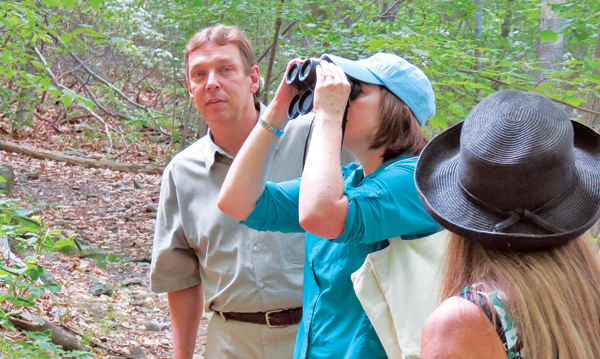

During a June 4 hike through Black Rock Forest, Erin Crotty of the New York Audubon Society aims her binoculars at a bird flying overhead. With her is Dr. Bill Schuster of the Black Rock Forest Consortium.
While some people were sleeping or having breakfast on Saturday morning, a group of bird enthusiasts wandered the trails of Black Rock Forest. With the help of Erin Crotty, the executive director of the state Audubon Society, the group identified 33 different species.
Their experience confirmed what they heard at a press conference soon after their trek was over — Black Rock Forest is now part of the Hudson Highlands West Important Bird Area (IBA).
The Audubon Society added the forest, and the lands around it, to an IBA that formerly ended at the northern edges of Harriman State Park and Sterling Forest.
The change follows an effort by Dr. Terryanne Maenza-Gmelch of Barnard College and the Black Rock Forest Consortium, who conducted a survey of the birds in the forest and prepared the application that the Audubon Society approved.
Dr. Bill Schuster, the executive director of the consortium, praised Dr. Maenza-Gmelch at the June 4 press conference at the forest lodge.
“We want to thank her…,” he said, “for many early mornings and long hours of bird survey work in the field, together with her students, which we know she enjoyed.”
The final statement got the laugh that Dr. Schuster expected. The audience also chuckled when he described the role of birds in the ecosystem. “Besides being beautiful and bringing joy to us,” he said, “birds provide critical ecosystems services that are too often overlooked. For example…, birds are a big part of the reason why the gypsy moth is no longer a major problem (they have become naturalized in our region), because one of the most effective ways to deal with invasive species is to have native species eat them.”
The new designation will affect community and land use planning. A joint press release from the Consortium and the Audubon Society included a statement from David Church, the Orange County Planning Commissioner. “By knowing in advance where important [bird] habitats are,” he said, “we can be smarter about our activities and investments.”
June 4 was a busy day in the forest. Besides the birding hike and the press conference, Black Rock hosted a fifth-grade overnight trip, a two-day ecological study by high school seniors, a team of interns from Barnard College and the University of Florida, and an expedition by 40 botanists from New England.
“And that’s not an unusual day here,” Dr. Schuster admitted.
